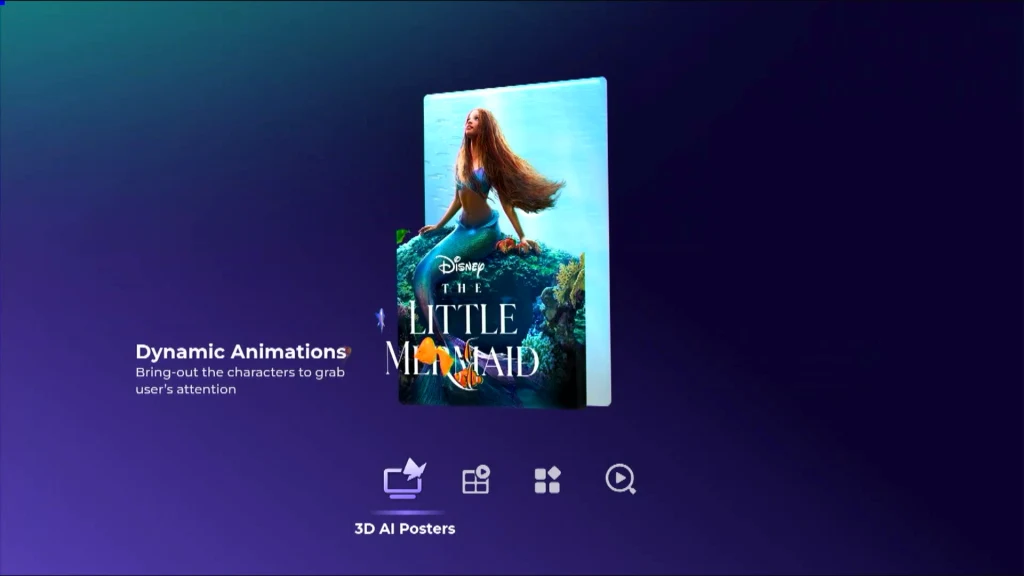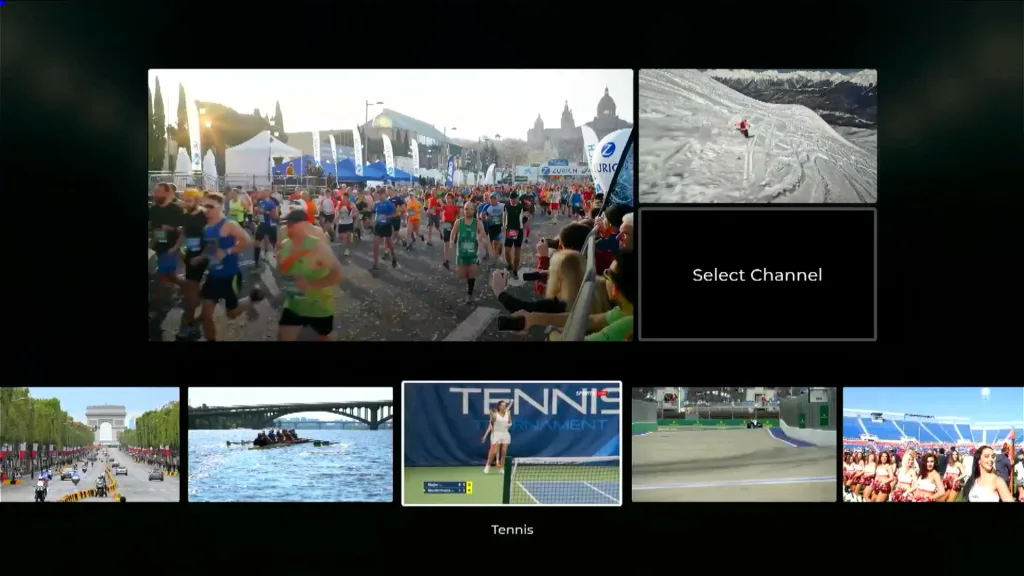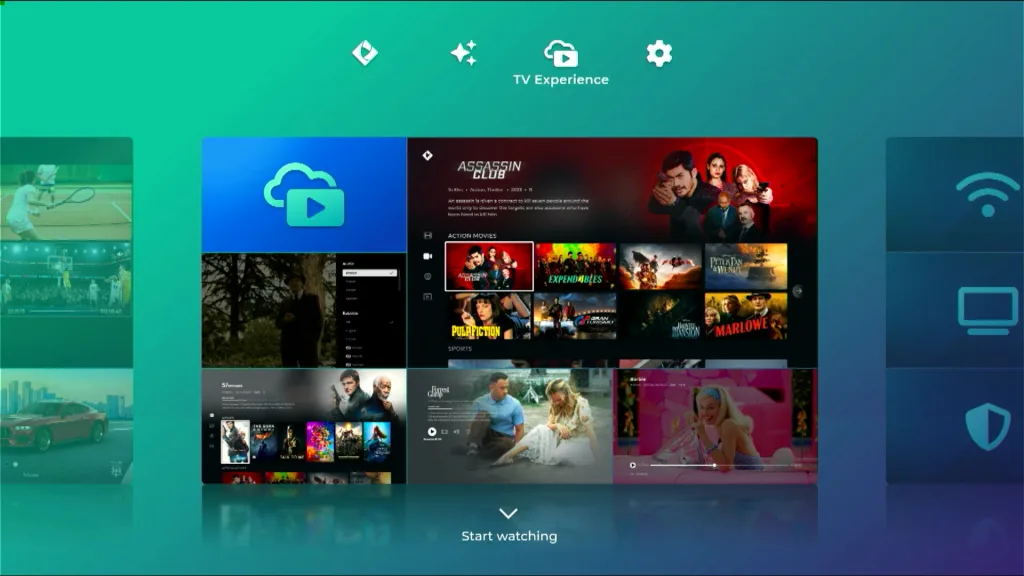Synamedia’s Senza is the dumbest streaming device I’ve ever used. It only costs about $10, and the hardware alone isn’t capable of much more than loading a video stream from a bare-bones menu system.
But that’s the point. Synamedia, which mainly offers content protection and other services to streaming providers, is trying to rethink the streaming box by moving all the smarts to the cloud. In a nod to cloud gaming services such as Nvidia GeForce Now, and Xbox Cloud Gaming, Senza’s entire interface is rendered on remote servers, then streamed onto a tiny, low-power set-top box. This allows Senza to do things that would otherwise require much pricier hardware, such as flashy animations and split-screen channel viewing.
It’s not something you’ll be able to buy, though. Synamedia is offering Senza to internet providers, TV operators, and media companies that want to run their own streaming platforms. By allowing more players to enter the business with little upfront expense, Synamedia is hoping to upend the business model for streaming devices.
“What we wanted to do, to some degree, is use this as an opportunity to see if we could democratize the access to the TV again,” says Nick Thexton, Synamedia’s executive vice president of media cloud services.

Proof of concept
Synamedia sent over a prototype to demonstrate how Senza will work, though its capabilities are pretty basic. I could scroll through a set of menu panels, watch a handful of streaming services, and view a few demos, and that’s about it.
For a device that costs $10, it’s both more and less performant than you might expect. A dramatic gliding animation kicks in while scrolling between menu tiles, and a demo of poster art for Disney’s The Little Mermaid art expands into 3D when selected, but the animations are also a bit choppy and prone to stuttering.

The most impressive demo involves setting up multiview from a set of sample videos, with the ability to play up to four videos at the same time. Multiview is tricky to offer on conventional streaming devices because of the computing power required. Streaming services that support multiview either limit it to powerful devices like the Apple TV 4K (as FuboTV does), or they process specific video combinations on their own servers as YouTube TV does, thereby limiting which channels you can pair together.

By rendering the entire interface in the cloud, Senza could in theory make multiview more accessible. Same goes for other interactive features such as karaoke or e-commerce integration.
“We’re trying to give people a different set of experiences, not just the plain old TV one, but actually give the opportunity for growth of a whole variety of different things,” Thexton says.
Pay as you go
TV providers already have other ways of distributing their services on their own branded hardware. DirecTV, for instance, uses Google’s Android TV platform for its internet-based set-top boxes, and TiVo offers a customized version of its Android TV streaming dongle for broadband providers such as Astound. At retail, that same TiVo dongle only costs about $25—not much more than what Synamedia is asking before cloud computing fees.
But Synamedia’s business model is different from most streaming platforms. Instead of taking a cut of revenues from ads or subscriptions, it will charge video providers for cloud computing resources, with some profit margin for Synamedia built in. Thexton says providers only pay for time that viewers spend browsing the interface—a handful of dollars per month—rather than watching video.

That means TV providers will shoulder ongoing costs just to keep the devices running, but Thexton argues that they’re getting value in return. They won’t have to share the revenue they generate, worry about device maintenance or security patches, or compete with platform providers such as Google for real estate on the home screen.
“You don’t need to ask our permission to be the primary number-one application on this platform,” he says. “There’s no Google, there’s no searching, there’s nobody between us and you.”
Partners needed
Launching a new streaming platform isn’t easy, though, and Synamedia isn’t coming out of the gate with an expansive roster of partners.
Its biggest is BeIN, a Qatar-based sports channel owner. SuperCloud, a Fort Lauderdale-based MVNO, also plans to use Senza to deliver a live TV package for its 5G home internet subscribers. Other partners include Barvanna, which serves trivia and other content on bar and restaurant televisions, and OTTera, a white-label distributor of ad-supported streaming channels. Synamedia wants to offer a large selection of third-party apps on its devices, and it showcased Pluto TV on the prototype I received, but I’m told that was just for demo purposes.
Lena Wasikowski, Synamedia’s head of content, says that because Senza apps are HTML5-based, supporting the platform only requires “a little bit of technical integration,” but the company is still talks with various streaming video services
“They basically wanted to see that this was a publicly launched service before they complete the technical integration, but those will be coming for the most part as we launch with different TV operators,” she says.
There is, perhaps, a more fundamental challenge: Plenty of folks are perfectly happy buying their own streaming devices or using whatever software is built into their smart TVs. And even in cases where people might accept a streaming device from their TV provider, the big players such as Comcast and Spectrum have already developed products of their own.
All of which means that Senza is not going to be taking over your living room anytime soon, but the idea of cloud computing on streaming devices is worth considering regardless. Most people already buy the cheapest streaming hardware possible; maybe it’s a way to deliver a better experience in process.
Melden Sie sich an, um einen Kommentar hinzuzufügen
Andere Beiträge in dieser Gruppe

Sensitive financial and health data belonging to millions of

Dating apps are a notoriously

Slightly under 10 years ago, when I reviewed a new Apple MacBook, I devoted a surprising percentage of my wordage to its port.

WeWard, an app that offers real-world rewards for walking, announced Wednesday it’s signed tennis champ Venus Williams as an investor and ambassador

When Netflix reality show Dubai Bling debuted in 2022, it became a global sensation, garnering viewers across 51 countries. And it’s kept up the momentum: The show’s recently

Quantum researchers are in a race for qubits, and Microsoft is in the thick of the competition.
Microsoft has spent the last 20 years pursuing a topological approach to quantum developme

It’s been a year since Intuitive Machines (IM) made history with the first private soft landing and first
